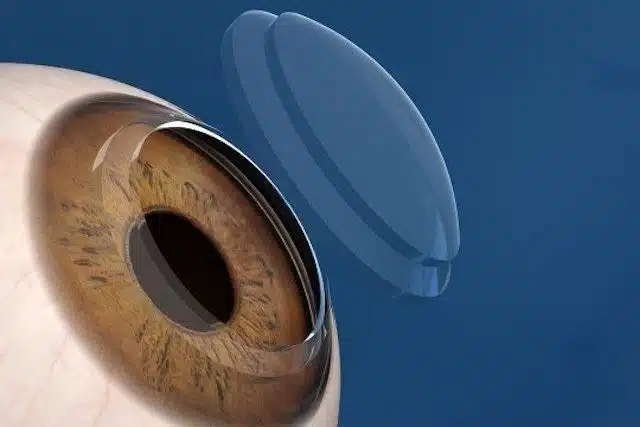Corneal transplant or corneal transplantation is a surgical procedure to replace total or a part of a damaged corneal endothelium tissue with a normal corneal tissue from a donor. The cornea is a transparent and colorless tissue in front of your eye covering anterior chamber of your orbit. Lights enter your eyes through cornea. Cornea has a special curved structure that refracts the light direction into eye lens and finally focuses near or far object’s picture on your retina, so you could see the objects. In most prevalent corneal transplant technique, ophthalmologist surgeon cuts total or a part of damaged corneal tissue to remove the middle part of cornea which is named disc. A high-tech instrument is used to make a fine circle cut.
corneal transplantation techniques:
Some patients may need total tissue corneal transplant. In this case, total damaged corneal tissue replace with a normal cornea. Other patients may need replacement of a damaged layer of a corneal tissue, so the damaged corneal layer replace with a normal corneal layer.
Methods of performing corneal transplantation
Before corneal transplantation, the patient is first examined and tested. Then, using precision microscopes, a circular fragment is removed from the recipient corneal surface and then precisely the same area is cut from the donor corneal surface and transplanted to the patient with very fine sutures.

There are different types of corneal transplant surgery, including:
The traditional method of corneal transplantation
The traditional method of corneal transplantation in which the physician removes a portion of the cornea with a thickness of the entire cornea from the patient’s eye by means of a special and precise instrument, and then cuts a portion exactly in the same form as the donor’s cornea and sutures. Very subtle transplants are performed on the patient’s eye. Also, the stitches usually remain in the eye for up to a year. You can go home after a few hours of surgery.
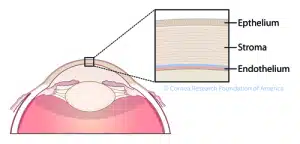
Corneal transplantation by endothelial keratoplasty
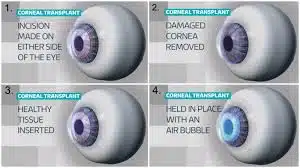
Anterior lamellar keratoplasty (ALK)
During this procedure, doctors will approach the frontal part of corneal, including the epithelium and stroma layers. Diseased tissue will be removed without affecting the endothelial. However, depending on the type of ALK, this procedure can be divided into sub-groups. For instance, if only the frontal layers of the cornea are affected, the process will be grouped as superficial anterior lamellar keratoplasty (SALK). In the case of extensive grave damage of stroma, the procedure will be divided into a sub-group of deep anterior lamellar transplant (DALK). During DALK, the cornea’s middle and front layers will be removed by a small incision in the side of the eyeball. Therefore, the healthy back layers of the cornea will remain unaffected. Later on, damaged tissues will be replaced with donor tissues.

Corneal Transplant Cost in Iran by TebMedTourism company

How much does corneal transplant cost in Iran compared with other countries?
Many factors may influence corneal transplant cost including corneal processing costs, the surgeon’s fee, used medications and instruments cost, ophthalmology clinic’s charge and anesthesia costs. Iran eye bank is a NGO that collect, process and distributes cornea to corneal transplant candidates.
How much does corneal transplant cost in different countries?
The average cost of corneal transplant in India is 2000$. The cost may vary depending on the cities and clinics. Corneal transplant cost for Indians varies between 50,000 Rupees to 100,000 Rupees. In India, corneal transplant is done just in private clinics and hospitals. Recently, Indian government provides corneal transplant economic facilities for needy Indians. In USA, corneal transplant cost depends on the patients insurance. Providing cornea costs between 2000$ to 2500$. The surgeon’s fee cost between 800$ to 1200$. The ophthalmology clinic and operation room charge cost 2000$. Anesthesia fees cost between 400$ to 600$. Totally, corneal transplant cost in USA varies between 5200$ to 6300$. In Dubai, UAE, Corneal transplant cost depends on many factors including age, corneal transplant technique, underlying diseases, etc. The average corneal transplant cost in UAE starts from 6000$.
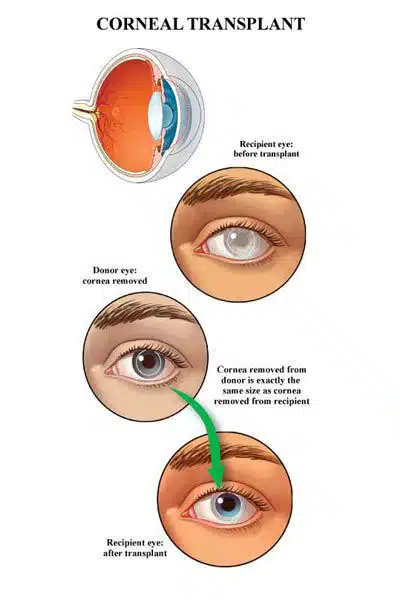
When should you consider cornea transplant?
- Keratoconus: keratokonus may cause corneal thinning, corneal rupture or even blindness over time.
- Corneal opacity: corneal transplant will improve vision of patients with corneal opacity.
- Corneal rupture due to eye trauma.
- Corneal spots: corneal transplant is the soul permanent treatment for corneal spots. Some patients may use cosmetic eye lenses which may cause many side effects as a temporary solution.
- Corneal severe infections: infections may damage corneal normal structure.
In what cases may we need a corneal transplantation?
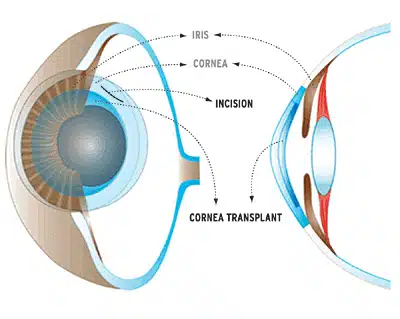
There are many cases due to which you will need corneal transplantation:
- When a person has keratoconus
- Focus Dystrophy
- Corneal thinning
- Corneal ulcers caused by infection and injury
- Corneal swelling
- Complications from previous eye surgeries such as cataract or LASIK
- Corneal burns due to chemicals
- Corneal edema
Pros and Cons Corneal Transplant
Corneal transplant is relatively safe and the surgery is safe and often improves vision but can have complications like any other surgeries, including infection, glaucoma, cataracts, graft rejection, and astigmatism. In corneal transplantation, unlike other transplant operations in humans, there is no need to examine the blood group or tissue compatibility between donor and recipient, and the healthy cornea of any individual can be transplanted to any other person.
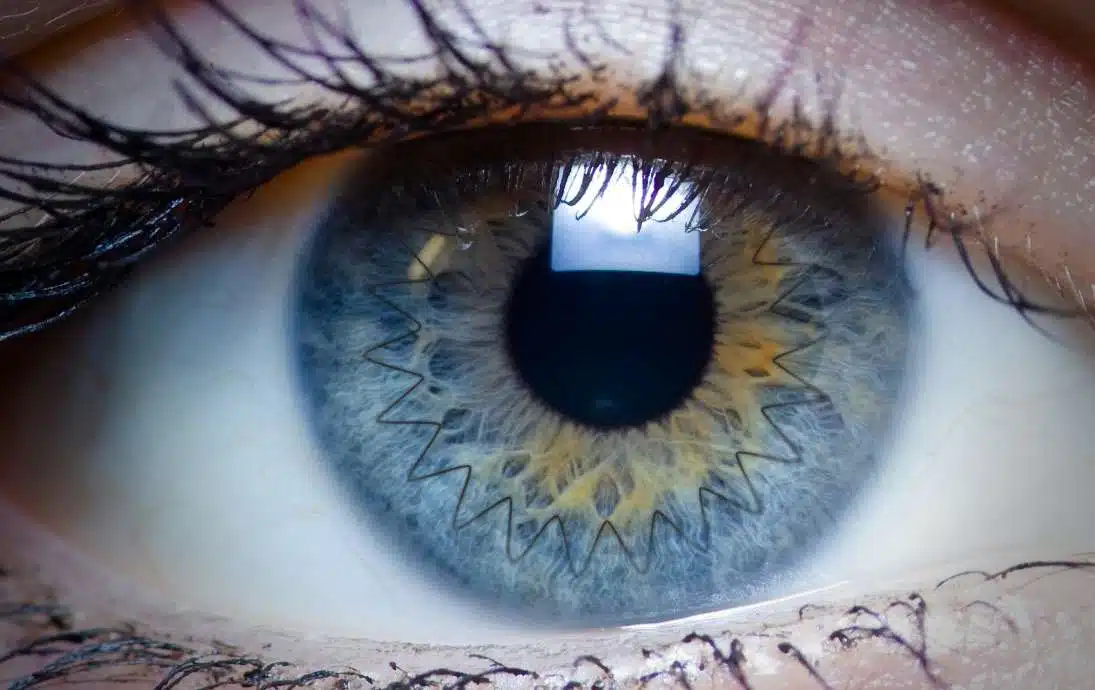
- Tranplant rejection
Sometimes the recipient’s immune system is activated against the donor cornea, causing corneal opacity, pain and redness of the eye, and vision loss, called transplant rejection, which occurs years after surgery. In most cases, transplant rejection is controlled by a physician and the cornea becomes clear again. Therefore, it is recommended that a patient who has a corneal transplant see his doctor if he has pain, redness, and vision loss.
- High Astigmatism
The most common complication of corneal transplantation is the development of astigmatism, which is usually improved by adjusting and removing sutures and by wearing glasses or contact lenses.
What you should do after a corneal transplantation
There are some points that you should observe after corneal transplantation:
- You should take the medicine for a few days. These drugs are both in the form of eye drops and oral tablets. These drugs are used to prevent infection after transplantation.
- Wear blindfolds to provide adequate eye protection after surgery
- After the surgery you need to protect your eyes from injury.
- Be sure to have your surgeon’s checkups regularly to closely monitor the recovery process.
There is a risk of complications and rejection of the cornea for years after surgery, so consulting a physician is essential
Is there a waiting list for corneal transplant?
Corneal tissue comes from a deceased volunteer of organ donation. Due to the possibility of donating cornea tissue for everyone after death, the waiting list for corneal transplant is not too long compared with other organ transplantations.
How long does it take to recover from a corneal transplant?
Your vision might be opaque after corneal transplant for a while time. Most patients experience benefits of corneal transplant in 6 to 12 weeks. Recommended postoperative cares improve your vision recovery and reduce probability of corneal rejection.
What is the success rate of a corneal transplant?
Corneal transplant surgery has been proved to be successful in many cases; however, the risk of corneal rejection is somewhat high. Corneal transplant is a prevalent operation with high success rate in Iran. In fact, corneal transplant is the most successful organ transplantation in the world.
- Corneal transplant is ongoing and has an acceptable success rate. In fact, the cornea has the best tissue transplant results. If rejection of the corneal transplant is detected quickly, it can be prevented in 9 out of 10 cases. Complications of corneal transplantation are significant and can include graft rejection, eye infection, and suture problems. Recurrence of donor tissue after a corneal transplant is the most serious complication and occurs in 5 to 30% of patients. Identifying the main warning signs after transplantation is the first step to prevent transplant failure.
- Eye redness
- Severe sensitivity to light
- Decreased vision
- Pain
- Light sensitivity
- Abnormal tears
- Blurred vision
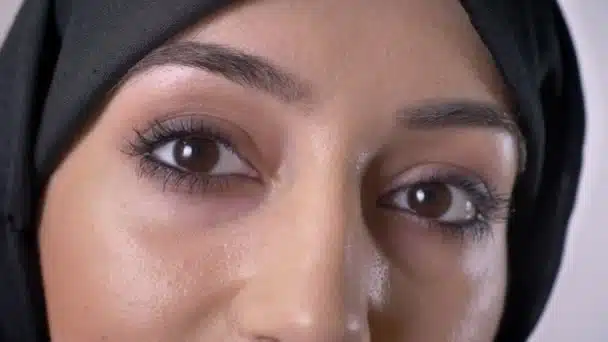
- Other major complications of corneal transplantation are less common, but complications such as intraocular hemorrhage, infection, cataracts, glaucoma, recurrent corneal disease, and retinal detachment
If your corneal transplant fails, transplant surgery can be repeated.
What are the side effects of corneal transplant surgery?
Patients will experience irritation, sensation to light, and red eyes. Moreover, increased tearing and discharge are expected after the surgery. Fortunately, these side-effects can be controlled with Tylenol and other types of acetaminophen a few days after surgery.
How would the patient’s vision change after the corneal transplant surgery?
Following the corneal transplant surgery, the patient may experience blurry vision, but this condition will improve soon. Once inflammation of operation fades away, and sutures get removed, the shape of cornea will be changed. This can take some time between 2 to 13 months, and the patient will get new glasses or lenses only after this time. If needed, doctors may prescribe contact lenses.







